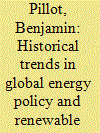| Srl | Item |
| 1 |
ID:
186469


|
|
|
|
|
| Summary/Abstract |
Marine energy (i.e., energy from waves, tides, currents) in the United States is a nascent industry. In particular, permitting processes—an uncertainty for industry advancement that can be costly and time consuming to navigate—have rarely been tested and used for marine energy. The novelty of the marine energy industry and utilization of open ocean permitting processes that were not originally developed for marine energy have led to extensive efforts to gain consensus amongst state and federal regulatory agencies to authorize marine energy projects. In 2021, Oregon State University successfully completed permitting of a wave energy test facility, called PacWave South, off the coast of Oregon, which is designed to advance wave energy research and development. This article documents the multi-year process that Oregon State University used to receive federal and state authorization for a pre-permitted commercial-scale grid-connected facility by detailing the development of the test facility, management of uncertainty and challenges, and key decisions. The PacWave South case study provides insights for the larger marine energy community as the industry advances towards commercialization.
|
|
|
|
|
|
|
|
|
|
|
|
|
|
|
|
| 2 |
ID:
166313


|
|
|
|
|
| Summary/Abstract |
From 1972 and the Meadows report to 1997 and the ratification of the Kyoto Protocol by most of the countries in the world, the global energy policy framework has moved on to considering the concept of sustainable development. Regarding electrification, modern renewable power systems such as solar PV have sprung up in the wake of this major mutation and have typically undergone a significant growth since the beginning of this century. In this paper, we first investigate the historical interactions between energy and society in both global and Sub-Saharan contexts and how renewable power has ended up being considered accordingly. From the need for sustainable development to grid-connected architecture on the one hand; from the lack of human development to rural off-grid electrification on the other. Then, using the case of solar PV, we propose a reading of the issues and challenges renewable power systems are currently facing in Sub-Saharan Africa, by linking those aspects to the previously stated global policy framework, and in particular the historical segmentation of the renewable energy worldwide market between grid-connected and off-grid sectors.
|
|
|
|
|
|
|
|
|
|
|
|
|
|
|
|